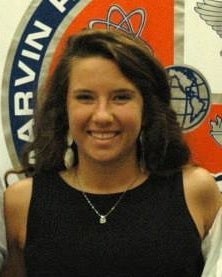April 21, 2015
Between the Lens: Photography and Writing Seminar
By: Kayla Thompson, Honors College Sophomore
 As a student majoring in Multidisciplinary Studies with a concentration in Neuroscience, everything about an Honors College seminar with a fine arts credit made me uneasy. The lecture took place on the opposite end of campus away from my comfort of the Science and Technology building. I trudged to the other side of campus every Tuesday and Thursday morning. Navigating through the Jenkins Fine Art building was a tough task in its own. Then, they suggested I hop in a rusty, white van and go to Duke University to look at art. This would need some convincing.
As a student majoring in Multidisciplinary Studies with a concentration in Neuroscience, everything about an Honors College seminar with a fine arts credit made me uneasy. The lecture took place on the opposite end of campus away from my comfort of the Science and Technology building. I trudged to the other side of campus every Tuesday and Thursday morning. Navigating through the Jenkins Fine Art building was a tough task in its own. Then, they suggested I hop in a rusty, white van and go to Duke University to look at art. This would need some convincing.
I continued to steer to the far end of campus and attend this class that discussed a connection between photography and writing. Dr. Charles Twardy, a professor of the School of Communication, and Dr. Daniel Kariko, a professor of the School of Art and Design, displayed concerns about many different issues including things. We explored many series of pictures that conveyed messages about the terrain located near and far from Greenville, North Carolina. Before I knew it, they asked my peers and I to do the same thing in Eastern North Carolina. Anything east of I-95 would suffice.
Dr. Twardy prepared us through writing exercises and lectures on how to interview people. He had us talk in class using the same words that he wanted us to write with: concrete nouns and verbs. Dr. Kariko plunged into efficiently handling cameras and adjusting settings along with some modern and historical examples of popular photographs. They both taught me a new perspective of art portrayed through not only pictures, but also writing.
On a Saturday morning, I jumped into the van and headed to Durham where the Center for Documentary Studies at Duke University awaited. I had the opportunity to explore black rooms for developing photographs along with seeing a real example of what our projects aspired to resemble. Lynsey Addario, a woman of many talents including  documentary photography, had an exhibit on display that we explored. She called it “Veiled Rebellion: Women in Afghanistan.” It was a rather silent reveal due to the emotion that flowed through the words and pictures on display. I felt for these women and had the opportunity to recognize a different culture thousands of miles away. These emotions were interpreted by looking a photograph and then reading the story behind each woman. For example, a young girl had marks all over her face. After reading, I learned that this particular girl had acid sprayed onto her when walking to school because some men in their country do not encourage getting an education. The pictures were all interesting subjects but you developed an emotional attachment after reading Addario’s words that told exactly what was happening.
documentary photography, had an exhibit on display that we explored. She called it “Veiled Rebellion: Women in Afghanistan.” It was a rather silent reveal due to the emotion that flowed through the words and pictures on display. I felt for these women and had the opportunity to recognize a different culture thousands of miles away. These emotions were interpreted by looking a photograph and then reading the story behind each woman. For example, a young girl had marks all over her face. After reading, I learned that this particular girl had acid sprayed onto her when walking to school because some men in their country do not encourage getting an education. The pictures were all interesting subjects but you developed an emotional attachment after reading Addario’s words that told exactly what was happening.
In America, we are not exposed to women trapped under the claws of the Taliban. But, we do have other issues, even in Eastern North Carolina. I discovered this when I was asked to go explore and talk to people in the community. I have initiated interviews and captured photographs of these people five minutes after meeting them. Being enrolled in a fine art seminar through the Honors College has stretched my confidence in many areas of my education. Interacting with Drs. Kariko and Twardy has also allowed me to comfortably adjust to unknown areas of my surroundings. In short, I have been given the opportunity, along with many other students, to convey passion through a camera lens and write about relevant issues.
To see some of the pictures taken in Greenville by the class, click here.
